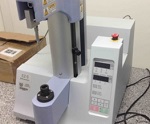Evaluation of the hardness of various foods
Keywords:
food consumption, bite force, masticatory efficiency, occlusal force.Abstract
Objective: evaluate the hardness of various food groups for mastication.
Methods: an in vitro descriptive study was conducted to evaluate the hardness of various tidbits, fried pork rinds and beef using the texture meter EZ-S Shimadzu. Statistical analysis of the data obtained was conducted on an individual basis with Shapiro Wilk and Kruskal-Wallis statistical tests, and Mann Whitney comparison test.
Results: of the food groups studied, the ones standing out for their hardness were the tidbit Coffee Delight® (hard coffee candy) with 268.25 N, followed by another tidbit, Bon Bon Bum® (lollipop) with 179.5 N and mints (hard mint candy) with 165.25 N. Beef and baked donuts exhibited lower values.
Conclusions: due to the intense force that must be applied to fracture and grind very hard food, its consumption constitutes a risk factor for natural teeth and dental restorations alike, since fractures may occur in restorative materials and dental organs.
Downloads

Published
How to Cite
Issue
Section
License
Authors retain all rights to their works, which they can reproduce and distribute as long as they cite the primary source of publication.
The Rev Cubana Estomatol is subject to the Creative Commons Attribution-Non-Commercial 4.0 International License (CC BY-NC 4.0) and follows the publication model of SciELO Publishing Schema (SciELO PS) for publication in XML format.
You are free to:
- Share — copy and redistribute the material in any medium or format.
- Adapt — remix, transform, and build upon the material.
The licensor cannot revoke these freedoms as long as you follow the license terms.
Under the following terms:
Attribution — You must give appropriate credit, provide a link to the license, and indicate if changes were made. You may do so in any reasonable manner, but not in any way that suggests the licensor endorses you or your use.
- NonCommercial — You may not use the material for commercial purposes.
No additional restrictions — You may not apply legal terms or technological measures that legally restrict others from doing anything the license permits.
Notices:
- You do not have to comply with the license for elements of the material in the public domain or where your use is permitted by an applicable exception or limitation.
- No warranties are given. The license may not give you all of the permissions necessary for your intended use. For example, other rights such as publicity, privacy, or moral rights may limit how you use the material.

